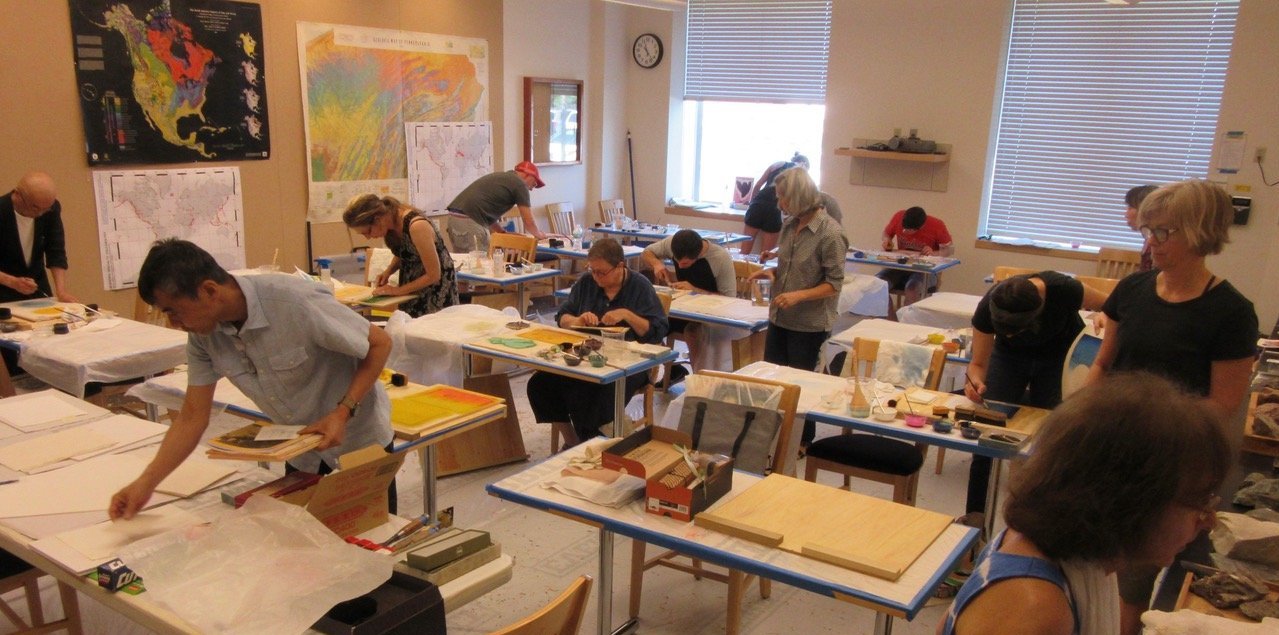
Promoting Mokuhanga Through Workshops, Residencies, and Exhibitions Since 2016
For information on upcoming workshops, residencies, and exhibitions check out our news page or follow us on our social media.
Our Organization
Mokuhanga Project Space is a 501(c)3 non-profit organization in Walla Walla, Washington, created to promote and support mokuhanga by exploring new dimensions of the art form in a global context.
A Brief History
Initially Keiko Hara began researching water-based arts and crafts in Japan because of environmental and safety concerns as an artist and educator. Keiko researched Ukiyo-E and taught mokuhanga printmaking at the Associated Kyoto Program, Doshisha University in Kyoto Japan in 1987. She discovered the unlimited possibilities for exploration and innovation while producing and exhibiting her mokuhanga prints. In 2013 she was invited to the first international mokuhanga artists residency at IMC in Tokyo.
In the Spring of 2014 professors Keiko Hara and Ron Takemoto from Whitman College curated an exhibition titled “Abstract American Mokuhanga” at the college’s Sheehan Gallery. This exhibition explored ways in which mokuhanga influenced and inspired American printmakers. The exhibition opened with a lecture by Karen Kunc and closed with a lecture and a workshop by Hiroki Morinoue.
In 2015, the Foundry Vineyards Gallery in Walla Walla hosted an exhibition titled “Exploring Fragility and Transience”, featuring several young Japanese mokuhanga artists. Additionally, Hiroki Satake from Tokyo Zokei University, provided a mokuhanga demonstration and gave a workshop at Whitman College. Three young Japanese mokuhanga artists and Florence Neal from New York participated in mokuhanga artist residencies. April Volmer also joined us and gave a lecture introducing her book, Japanese Woodblock Print Workshop: A Modern Guide to the Ancient Art of Mokuhanga.
Mokuhanga Project Space was founded as a non-profit organization by Keiko Hara in 2016 and has since offered many workshops, residencies, and demonstrations for the community.
Walla Walla
For millennia, the Cayuse, Umatilla and Walla Walla people lived on lands in southeast Washington and northeast Oregon States. They fished the Columbia and Snake Rivers and hunted game in the Blue Mountains. In 1805, Lewis and Clark's "Corps of Discovery" camped just north of nearby Dayton, WA. The Corps explorations initiated trading with the native people followed by early missionary settlements that included Marcus and Narcissa Whitman in 1836. Conflicts and disease ensued yet by 1862, Walla Walla was incorporated as a city. The Alaska gold rush fueled growth but those who remained in this region found the soil, thanks to the cataclysmic "Missoula Flood" 15,000 years ago, suitable for growing wheat, still the most viable commodity.
Whitman College was established in 1882. Culturally conscious pioneer women founded the Walla Walla Art Club in 1898, still extant today. The Art Club was followed in 1907 by the Walla Walla Symphony, which is the oldest operating symphony west of the Mississippi River. A state Penitentiary, a maximum-security prison, was constructed in 1886. Today, it houses over 2,000 inmates. A Veterans Administration Hospital opened in 1921 and recently, veterans' housing on the 88-acre V.A. campus was added. An office for the U.S. Army Corps of Engineers originated in 1938 to work on Blue Mountain spring flood mitigation.
Agriculture for wheat and legumes continues but between 1977 and 1983, three wineries opened: Leonetti Cellars, Woodward Canyon and L'Ecole No. 41. These wineries heralded 120 more in the ensuing years thus adding to the over 1000 wineries registered in Washington State. Today, downtown Walla Walla and the surrounding area host wine-making facilities and attractive tasting rooms. Walla Walla's population in 1900 was 10,000 while today, it is 34,000. The area has become a tourist destination because of the wine industry and the charming downtown. Hotel and motel accommodations abound along with good restaurants and captivating shops.



